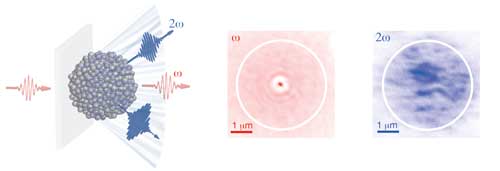Nanowerk October 13, 2020
In nonlinear crystals, two photons of a particular frequency can be turned into one photon having twice that frequency if they are phase matched. This often severely limits practical applications. Researchers in Switzerland combined resonances and disorder by implementing random quasi-phase-matching in Mie resonant spheres of a few micrometres realized by the bottom-up assembly of barium titanate nanocrystals. The measured second-harmonic generation reveals a combination of broadband and resonant wave mixing, in which Mie resonances drive and enhance the second-harmonic generation, while the disorder keeps the phase-matching conditions relaxed. The nanocrystal assemblies provide new opportunities for tailored phase matching at the microscale, beyond the coherence length of the bulk crystal. They can be adapted to achieve frequency conversion from the near-ultraviolet to the infrared ranges, are low cost and can cover large surface areas…read more. TECHNICAL ARTICLE

Inside the micrometre-sized spheres, the disordered nanocrystals frequency-double incoming red light into blue light (left). The blue light is emitted into different spatial directions (right). Credit: Romolo Savo / ETH Zurich